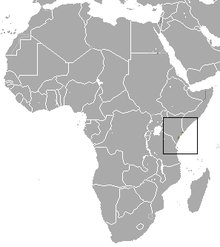
Elephant shrews, also called jumping shrews or sengis, are small insectivorous mammals native to Africa, belonging to the family Macroscelididae, in the order Macroscelidea. Their traditional common English name "elephant shrew" comes from a perceived resemblance between their long noses and the trunk of an elephant, and their superficial similarity with shrews in the order Eulipotyphla. However, phylogenetic analysis has revealed that elephant shrews are not properly classified with true shrews, but are in fact more closely related to elephants than to shrews. In 1997, the biologist Jonathan Kingdon proposed that they instead be called "sengis", a term derived from the Bantu languages of Africa, and in 1998, they were classified into the new clade Afrotheria.
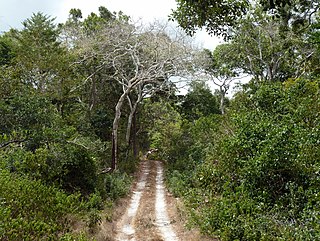
The Arabuko Sokoke Forest Reserve is located on the coast of Kenya, 110 km north of Mombasa and is protected as a national Forest Reserve. The Arabuko Sokoke National Park, situated at the north-western edge of the Arabuko Sokoke Forest Reserve, is only a few square kilometres in size and constitutes only a small portion of the latter.

The Sokoke scops owl is a highly localized species of scops owl found in lowland forests of Kenya and Tanzania. The greatest population of this species of owl is in the Cynometra-Manilkara forest, which is less than one-third of the Sokoke Forest. It is also found in the Afzelia-Cynometra forest.

The black and rufous elephant shrew, the black and rufous sengi, or the Zanj elephant shrew is one of the 17 species of elephant shrew found only in Africa. It is native to the lowland montane and dense forests of Kenya and Tanzania. Like other members of the genus Rhynchocyon, it is a relatively large species, with adults averaging about 28 cm (11 in) in length and 450–700 g (16–25 oz) in weight.

The short-snouted elephant shrew or short-snouted sengi is a species of elephant shrew in the family Macroscelididae. It is found over a wide area of Africa. Its natural habitats are dry savanna and subtropical or tropical dry lowland grassland.

The bushveld elephant shrew or bushveld sengi is a species of elephant shrew in the family Macroscelididae. It is found in Angola, Botswana, Namibia, and South Africa. Its natural habitats are subtropical or tropical dry shrubland and hot deserts.

The eastern rock elephant shrew or eastern rock sengi is a species of elephant shrew in the family Macroscelididae. It is found in Botswana, Mozambique, South Africa, and Zimbabwe. Its natural habitats are subtropical or tropical dry lowland grassland and rocky areas.

The Somali elephant shrew or Somali sengi is a species of elephant shrew in the family Macroscelididae.

The North African elephant shrew or North African sengi is a species of elephant shrew in the family Macroscelididae. It is found in Algeria, Libya, Morocco, and Tunisia, and is the only extant afrotherian within its range. The species was formerly classified in the genus Elephantulus, but molecular evidence indicates that it is more closely related to Petrodromus than to other members of Elephantulus. It was moved to a new genus, Petrosaltator, in 2016. The split with Petrodromus likely occurred during the Miocene period.

The rufous elephant shrew, rufous sengi or East African long-eared elephant-shrew is a species of elephant shrew in the family Macroscelididae. Found in Ethiopia, Kenya, Somalia, South Sudan, Tanzania and Uganda, its natural habitats are dry savanna and subtropical or tropical dry shrubland.
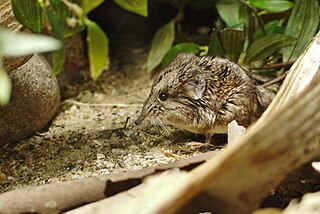
The round-eared elephant shrew or round-eared sengi, is a species of elephant shrew (sengi) in the family Macroscelididae. It is found in Botswana, Namibia, and South Africa. Its natural habitats are subtropical or tropical dry shrubland, and grassland, and hot deserts. They eat insects, shoots, and roots. Their gestation period is 56 days.
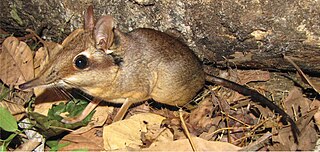
The four-toed elephant shrew or four-toed sengi is the only living species in the genus Petrodromus, which together with five other extant genera Rhynchocyon, Macroscelides, Petrosaltator, Galegeeska and Elephantulus constitutes the order Macroscelidea. This species is only found in particular regions in Africa and is smaller than its relatives. A comprehensive record of this species is lacking.

The checkered elephant shrew or checkered sengi is a species of elephant shrew in the family Macroscelididae.

Rhynchocyon is a genus of elephant shrew in the family Macroscelididae. Members of this genus are known colloquially as the checkered elephant shrews or giant sengis. It contains the following five species and several subspecies:
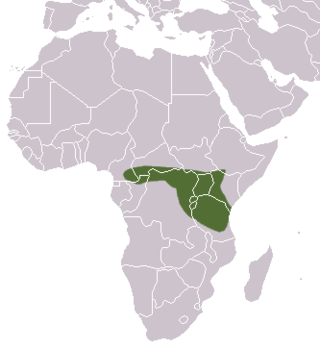
Hildegarde's shrew is a species of mammal in the family Soricidae. It is found in Burundi, Cameroon, Central African Republic, Republic of the Congo, Democratic Republic of the Congo, Ethiopia, Kenya, Rwanda, and Tanzania. Considered by some authorities to be a subspecies of Crocidura gracilipes, it is now recognised as a separate species, with a diploid chromosome number of 2n = 52. This is one of three species of small mammal named by the British zoologist Oldfield Thomas in honour of anthropologist Hildegarde Beatrice Hinde.

The grey-faced sengi is a species of elephant shrew that is endemic to the Udzungwa Mountains of south-central Tanzania. The discovery of the species was announced in January 2008; only 15 species of elephant shrew were known until then, and the last discovery was made more than 120 years ago. As the name implies, the species is characterised by a distinctive grey face and a black rump, as well as being larger than the other species of elephant shrews.

Macroscelides flavicaudatus is a species of elephant shrew in the family Macroscelididae found in the central Namib desert and southern Namibia.
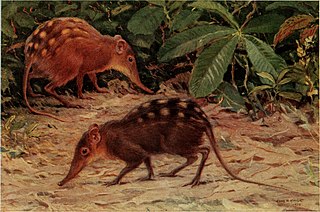
The Stuhlmann's elephant shrew is a species of elephant shrew that lives in the forests and savannas of Africa. It was discovered in 1893 and declared a new species. In the 1960s, however, it was downgraded to a subspecies of checkered sengi. In 2018, following genetic tests, scientists re-evaluated the mammal as a full species again.

